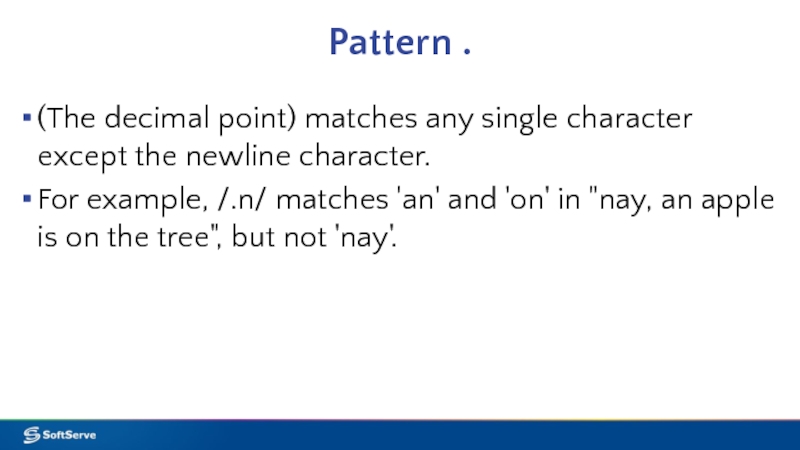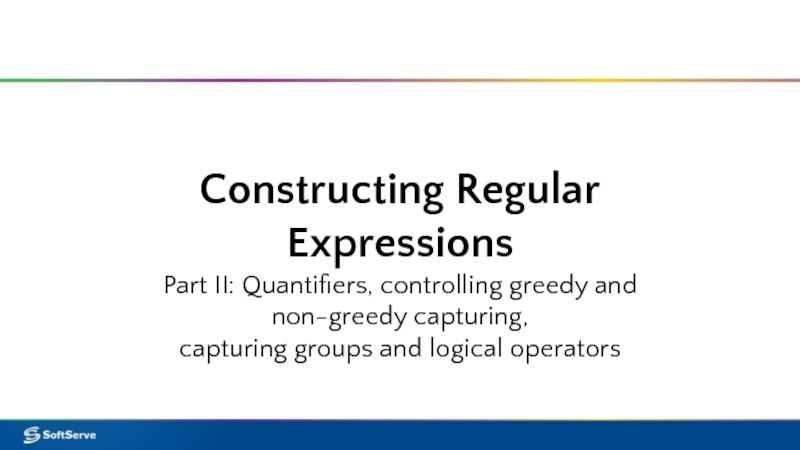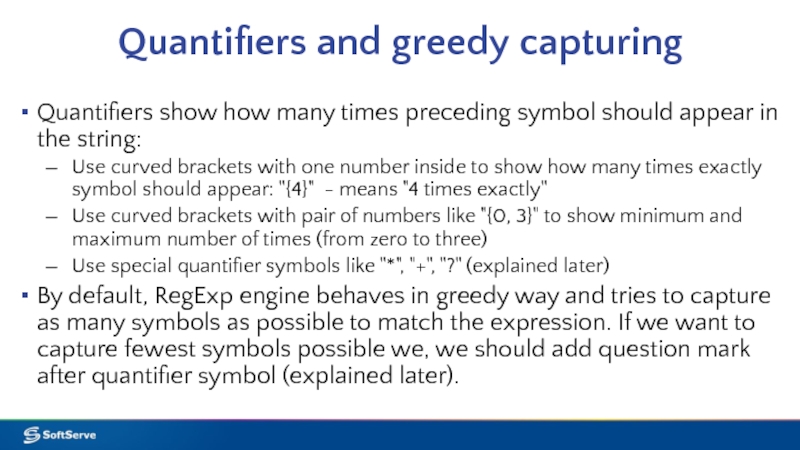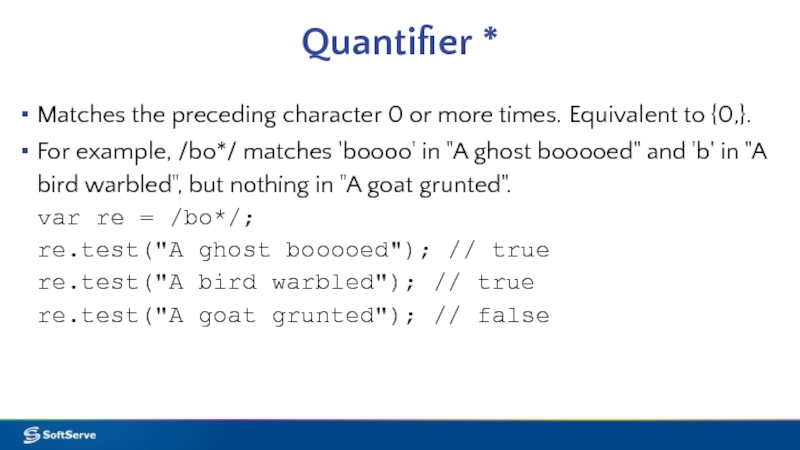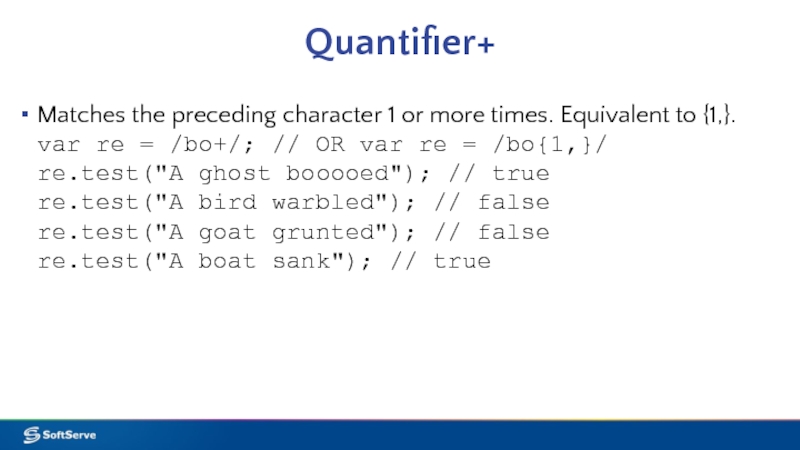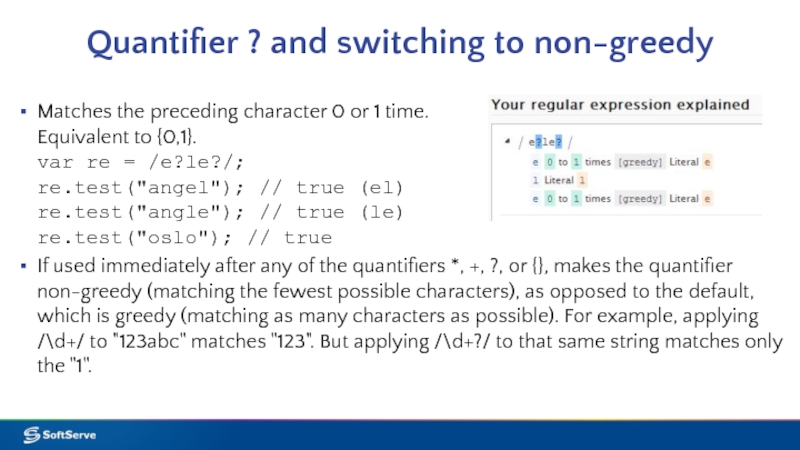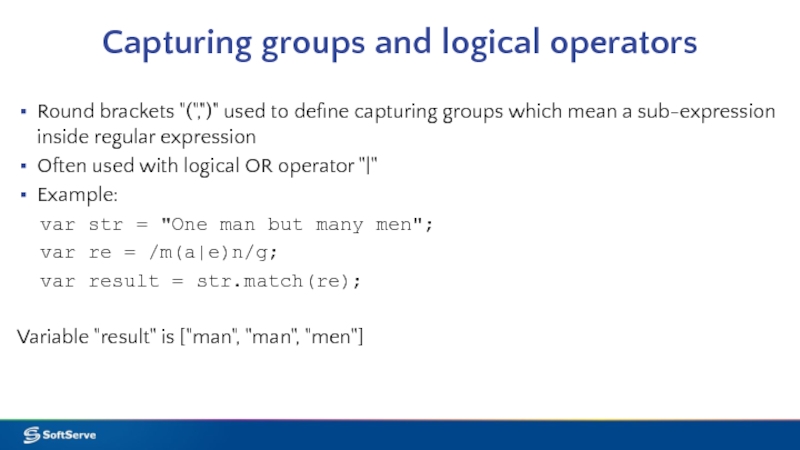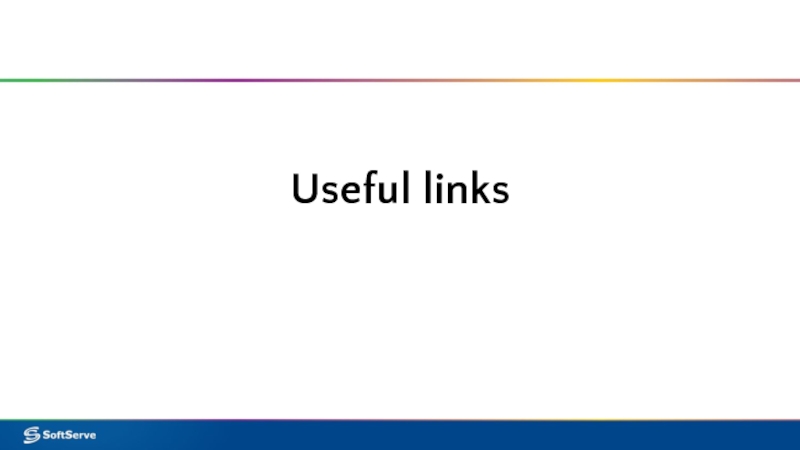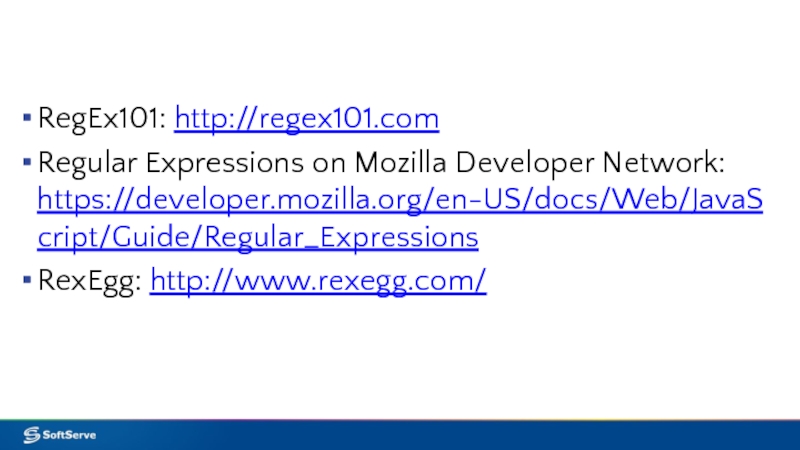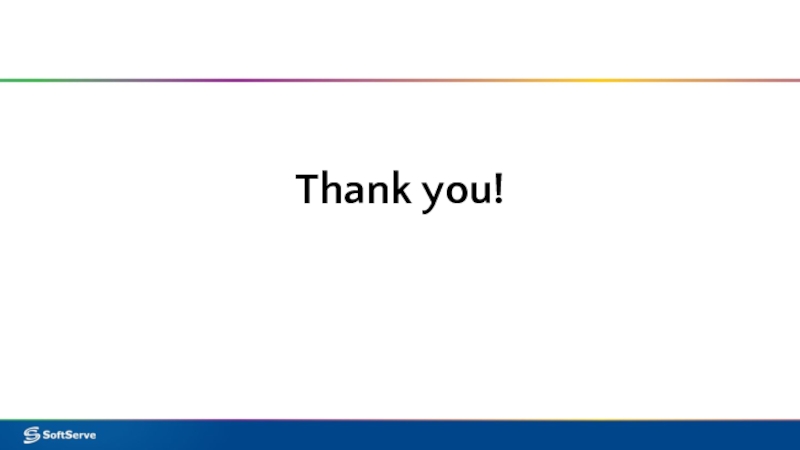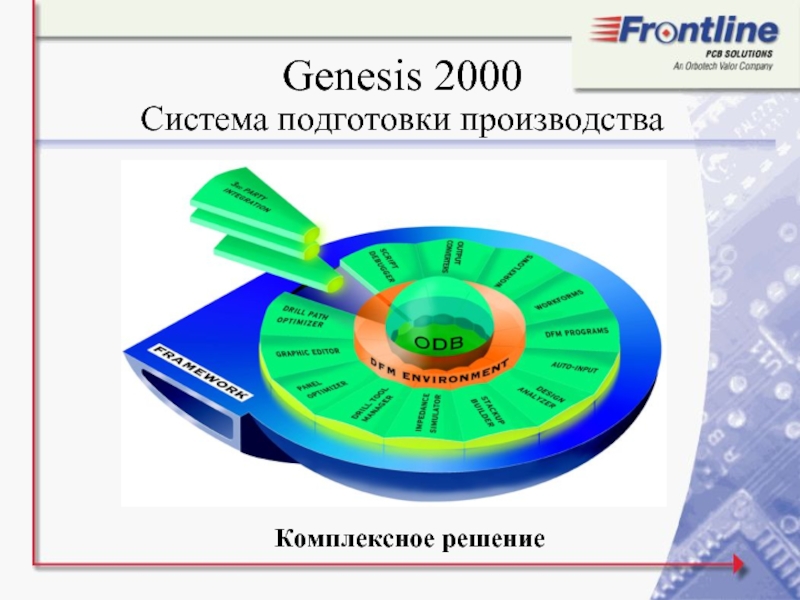- Главная
- Разное
- Дизайн
- Бизнес и предпринимательство
- Аналитика
- Образование
- Развлечения
- Красота и здоровье
- Финансы
- Государство
- Путешествия
- Спорт
- Недвижимость
- Армия
- Графика
- Культурология
- Еда и кулинария
- Лингвистика
- Английский язык
- Астрономия
- Алгебра
- Биология
- География
- Детские презентации
- Информатика
- История
- Литература
- Маркетинг
- Математика
- Медицина
- Менеджмент
- Музыка
- МХК
- Немецкий язык
- ОБЖ
- Обществознание
- Окружающий мир
- Педагогика
- Русский язык
- Технология
- Физика
- Философия
- Химия
- Шаблоны, картинки для презентаций
- Экология
- Экономика
- Юриспруденция
Module 8. Regular Expressions презентация
Содержание
- 1. Module 8. Regular Expressions
- 2. Agenda What is "Regular Expression"? Creating and
- 3. What is "Regular Expression"?
- 4. Concept of Regular Expressions Regular Expression (Regexp
- 5. Understanding basics Rexes string looks like "cent(er|re)"
- 6. Creating and running regular expressions in JavaScript
- 7. Create RegExp object JavaScript has special object
- 8. RegExp flags Regular expressions have four optional
- 9. RegExp method test() To check if RegExp
- 10. String method search() To find index in
- 11. String method match() To extract all matches
- 12. Using Regexes with HTML Forms HTML5 supports
- 13. Constructing Regular Expressions
- 14. Exact match and anchors Checking for EXACT
- 15. Character set match Checking for ONE OR
- 16. Negated character set Using caret symbol "^"
- 17. Special character: \ A backslash that precedes
- 18. Symbol ranges How to specify symbol ranges?
- 19. Pattern . (The decimal point) matches any
- 20. Constructing Regular Expressions
- 21. Quantifiers and greedy capturing Quantifiers show how
- 22. Quantifier * Matches the preceding character 0
- 23. Quantifier+ Matches the preceding character 1 or
- 24. Quantifier ? and switching to non-greedy Matches
- 25. Capturing groups and logical operators Round brackets
- 26. Useful links
- 27. RegEx101: http://regex101.com Regular Expressions on Mozilla Developer Network: https://developer.mozilla.org/en-US/docs/Web/JavaScript/Guide/Regular_Expressions RexEgg: http://www.rexegg.com/
- 28. Thank you!
Слайд 2Agenda
What is "Regular Expression"?
Creating and running regular expressions in JavaScript
Constructing regular
expressions:
Part I: Exact and character set match, basic special characters
Part II: Quantifiers, controlling greedy and non-greedy capturing, capturing groups and logical operators
Useful links
Part I: Exact and character set match, basic special characters
Part II: Quantifiers, controlling greedy and non-greedy capturing, capturing groups and logical operators
Useful links
Слайд 4Concept of Regular Expressions
Regular Expression (Regexp or Regex) is a special
sequence of characters that forms a search pattern.
The concept of Regex has been created in 1950s by American mathematician Stephen Kleene who formalized the description of a regular language.
Now Regexes are widely used to verify or extract required data and much more
The concept of Regex has been created in 1950s by American mathematician Stephen Kleene who formalized the description of a regular language.
Now Regexes are widely used to verify or extract required data and much more
Слайд 5Understanding basics
Rexes string looks like "cent(er|re)"
Each character in Regex may
be one of two types:
Regular character with its literal meaning
Special metacharacter with special meaning
In Regex "cent(er|re)" characters colored with green are regular characters with literal meaning while colored with red are metacharacters with special meaning
The Regex in example matches word "center" or "centre" in American or British spelling
Regular character with its literal meaning
Special metacharacter with special meaning
In Regex "cent(er|re)" characters colored with green are regular characters with literal meaning while colored with red are metacharacters with special meaning
The Regex in example matches word "center" or "centre" in American or British spelling
Слайд 7Create RegExp object
JavaScript has special object RexExp
There are two ways
to create an instance of it:
var myRE = new RegExp('SomeExpression');
var myRE = /SomeExpression/;
Important note: Variant 2 is preferred because special characters for string formatting are ignored here
var myRE = new RegExp('SomeExpression');
var myRE = /SomeExpression/;
Important note: Variant 2 is preferred because special characters for string formatting are ignored here
Слайд 8RegExp flags
Regular expressions have four optional flags that allow for global
and case insensitive searching.
To indicate a global search, use the g flag.
To indicate a case-insensitive search, use the i flag.
To indicate a multi-line search, use the m flag.
To perform a "sticky" search, that matches starting at the current position in the target string, use the y flag.
These flags can be used separately or together in any order, and are included as part of the regular expression.
To include a flag with the regular expression, use this syntax:
var re = /pattern/flags;
or
var re = new RegExp("pattern", "flags");
Note that the flags are an integral part of a regular expression. They cannot be added or removed later.
To indicate a global search, use the g flag.
To indicate a case-insensitive search, use the i flag.
To indicate a multi-line search, use the m flag.
To perform a "sticky" search, that matches starting at the current position in the target string, use the y flag.
These flags can be used separately or together in any order, and are included as part of the regular expression.
To include a flag with the regular expression, use this syntax:
var re = /pattern/flags;
or
var re = new RegExp("pattern", "flags");
Note that the flags are an integral part of a regular expression. They cannot be added or removed later.
Слайд 9RegExp method test()
To check if RegExp matches the string we should
use test() method of RegExp object.
This method accepts string and returns true if it finds a match, otherwise it returns false.
Example
Search a string for the character "o":
var str = "Hello";
var re = /o/;
var result = re.test(str);
Variable "result" is true
This method accepts string and returns true if it finds a match, otherwise it returns false.
Example
Search a string for the character "o":
var str = "Hello";
var re = /o/;
var result = re.test(str);
Variable "result" is true
Слайд 10String method search()
To find index in a string which corresponds match
for regular expression we should use method search() of a String object.
If successful, search returns the index of the first match of the regular expression inside the string. Otherwise, it returns -1.
Example
Find a position of the character "o" in a string:
var str = "Hello";
var re = /o/;
var result = str.search(re);
Variable "result" is 4
If successful, search returns the index of the first match of the regular expression inside the string. Otherwise, it returns -1.
Example
Find a position of the character "o" in a string:
var str = "Hello";
var re = /o/;
var result = str.search(re);
Variable "result" is 4
Слайд 11String method match()
To extract all matches of regular expression from a
string, use method match() of a String object. It accepts RegExp as a parameter and returns an array containing all matches or null if there where no matches.
Syntax:
str.match(regexp);
Important note: regular expression should include "g" flag, otherwise method will work same way as RegExp.exec() method which require a loop to get all matches.
Example
Extract all characters "o" from a string:
var str = "Hello World!";
var re = /o/g;
var result = str.match(re);
Variable "result" is ["o", "o"]
Syntax:
str.match(regexp);
Important note: regular expression should include "g" flag, otherwise method will work same way as RegExp.exec() method which require a loop to get all matches.
Example
Extract all characters "o" from a string:
var str = "Hello World!";
var re = /o/g;
var result = str.match(re);
Variable "result" is ["o", "o"]
Слайд 12Using Regexes with HTML Forms
HTML5 supports special attribute pattern for
elements of a form.
The pattern attribute specifies a regular expression that the element's value is checked against.
The pattern attribute works with the following input types: text, search, url, tel, email, and password.
Use the title attribute to describe the pattern to help the user.
Example form:
The pattern attribute specifies a regular expression that the element's value is checked against.
The pattern attribute works with the following input types: text, search, url, tel, email, and password.
Use the title attribute to describe the pattern to help the user.
Example form:
Слайд 14Exact match and anchors
Checking for EXACT match of some pattern string
inside ANY place of the test string:
var re = /pattern/;
re.test("some string to test pattern inside"); // true
re.test("there is no test string inside'); // false
Checking for EXACT match of pattern string from the BEGINNING of the test string: var re = /^pattern/; re.test("pattern starts string"); // true re.test("there is no pattern at the beginning"); // false
Checking for EXACT match of pattern string at the END of the test string: var re = /pattern$/; re.test("string ends with pattern"); // true re.test("there is no pattern at the end"); // false
Checking for EXACT match of pattern string from the BEGINNING of the test string: var re = /^pattern/; re.test("pattern starts string"); // true re.test("there is no pattern at the beginning"); // false
Checking for EXACT match of pattern string at the END of the test string: var re = /pattern$/; re.test("string ends with pattern"); // true re.test("there is no pattern at the end"); // false
Слайд 15Character set match
Checking for ONE OR MORE symbols at ANY place
in ANY order of the test string:
var re = /[abc]/;
re.test("bac"); // true
re.test("baac"); // true
re.test("bdac"); // true
re.test("fpirufieuhfa"); // true
re.test("sdfgsdfg"); // false
SAME but only at the BEGINNING: var re = /^[abc]/; re.test("bac"); // true re.test("baac"); // true re.test("fpirufieuhfa"); // false re.test("sdfgsdfg"); false
SAME idea at the END
SAME but only at the BEGINNING: var re = /^[abc]/; re.test("bac"); // true re.test("baac"); // true re.test("fpirufieuhfa"); // false re.test("sdfgsdfg"); false
SAME idea at the END
Слайд 16Negated character set
Using caret symbol "^" as first character set symbol
"negates" it, change meaning to opposite:
var re = /[^abc]/;
re.test("bac"); // false
re.test("baac"); // false
re.test("bdac"); // true
re.test("fpirufieuhfa"); // true
re.test("sdfgsdfg"); // true
Слайд 17Special character: \
A backslash that precedes a non-special character indicates that
the next character is special and is not to be interpreted literally.
For example, a 'b' without a preceding '\' generally matches lowercase 'b's wherever they occur. But a '\b' by itself doesn't match any character; it forms the special word boundary character.
A backslash that precedes a special character indicates that the next character is not special and should be interpreted literally. For example, the pattern /a*/ relies on the special character '*' to match 0 or more a's. By contrast, the pattern /a\*/ removes the specialness of the '*' to enable matches with strings like 'a*'.
Do not forget to escape \ itself while using the RegExp("pattern") notation because \ is also an escape character in strings.
A backslash that precedes a special character indicates that the next character is not special and should be interpreted literally. For example, the pattern /a*/ relies on the special character '*' to match 0 or more a's. By contrast, the pattern /a\*/ removes the specialness of the '*' to enable matches with strings like 'a*'.
Do not forget to escape \ itself while using the RegExp("pattern") notation because \ is also an escape character in strings.
Слайд 18Symbol ranges
How to specify symbol ranges?
var re = /[a-z]/; // from
a to z
var re = /[a-zA-Z]// from a to Z
var re = /[0-9]/; // from 0 to 9
Using special characters for symbol ranges: \w - Matches any alphanumeric character including the underscore. \W - Matches any non-word character. Equivalent to [^A-Za-z0-9_]. /\w/ == /[a-zA-Z0-9_]/ /\W/ == /[^A-Za-z0-9_]/ /\d/ == /[0-9]/
Using special characters for symbol ranges: \w - Matches any alphanumeric character including the underscore. \W - Matches any non-word character. Equivalent to [^A-Za-z0-9_]. /\w/ == /[a-zA-Z0-9_]/ /\W/ == /[^A-Za-z0-9_]/ /\d/ == /[0-9]/
Слайд 19Pattern .
(The decimal point) matches any single character except the newline
character.
For example, /.n/ matches 'an' and 'on' in "nay, an apple is on the tree", but not 'nay'.
For example, /.n/ matches 'an' and 'on' in "nay, an apple is on the tree", but not 'nay'.
Слайд 20
Constructing Regular
Expressions
Part II: Quantifiers, controlling greedy and
non-greedy capturing,
capturing groups and logical operators
Слайд 21Quantifiers and greedy capturing
Quantifiers show how many times preceding symbol should
appear in the string:
Use curved brackets with one number inside to show how many times exactly symbol should appear: "{4}" - means "4 times exactly"
Use curved brackets with pair of numbers like "{0, 3}" to show minimum and maximum number of times (from zero to three)
Use special quantifier symbols like "*", "+", "?" (explained later)
By default, RegExp engine behaves in greedy way and tries to capture as many symbols as possible to match the expression. If we want to capture fewest symbols possible we, we should add question mark after quantifier symbol (explained later).
Use curved brackets with one number inside to show how many times exactly symbol should appear: "{4}" - means "4 times exactly"
Use curved brackets with pair of numbers like "{0, 3}" to show minimum and maximum number of times (from zero to three)
Use special quantifier symbols like "*", "+", "?" (explained later)
By default, RegExp engine behaves in greedy way and tries to capture as many symbols as possible to match the expression. If we want to capture fewest symbols possible we, we should add question mark after quantifier symbol (explained later).
Слайд 22Quantifier *
Matches the preceding character 0 or more times. Equivalent to
{0,}.
For example, /bo*/ matches 'boooo' in "A ghost booooed" and 'b' in "A bird warbled", but nothing in "A goat grunted". var re = /bo*/; re.test("A ghost booooed"); // true re.test("A bird warbled"); // true re.test("A goat grunted"); // false
For example, /bo*/ matches 'boooo' in "A ghost booooed" and 'b' in "A bird warbled", but nothing in "A goat grunted". var re = /bo*/; re.test("A ghost booooed"); // true re.test("A bird warbled"); // true re.test("A goat grunted"); // false
Слайд 23Quantifier+
Matches the preceding character 1 or more times. Equivalent to {1,}.
var
re = /bo+/; // OR var re = /bo{1,}/
re.test("A ghost booooed"); // true
re.test("A bird warbled"); // false
re.test("A goat grunted"); // false
re.test("A boat sank"); // true
Слайд 24Quantifier ? and switching to non-greedy
Matches the preceding character 0 or
1 time.
Equivalent to {0,1}.
var re = /e?le?/;
re.test("angel"); // true (el)
re.test("angle"); // true (le)
re.test("oslo"); // true
If used immediately after any of the quantifiers *, +, ?, or {}, makes the quantifier non-greedy (matching the fewest possible characters), as opposed to the default, which is greedy (matching as many characters as possible). For example, applying /\d+/ to "123abc" matches "123". But applying /\d+?/ to that same string matches only the "1".
If used immediately after any of the quantifiers *, +, ?, or {}, makes the quantifier non-greedy (matching the fewest possible characters), as opposed to the default, which is greedy (matching as many characters as possible). For example, applying /\d+/ to "123abc" matches "123". But applying /\d+?/ to that same string matches only the "1".
Слайд 25Capturing groups and logical operators
Round brackets "(",")" used to define capturing
groups which mean a sub-expression inside regular expression
Often used with logical OR operator "|"
Example:
var str = "One man but many men";
var re = /m(a|e)n/g;
var result = str.match(re);
Variable "result" is ["man", "man", "men"]
Often used with logical OR operator "|"
Example:
var str = "One man but many men";
var re = /m(a|e)n/g;
var result = str.match(re);
Variable "result" is ["man", "man", "men"]
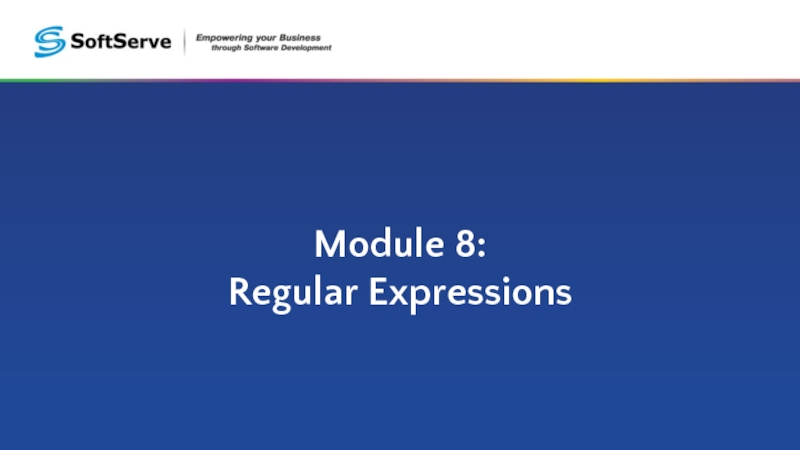
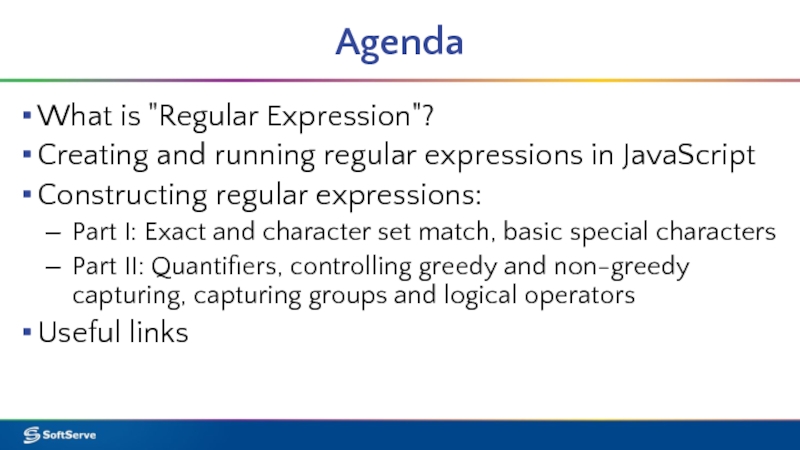
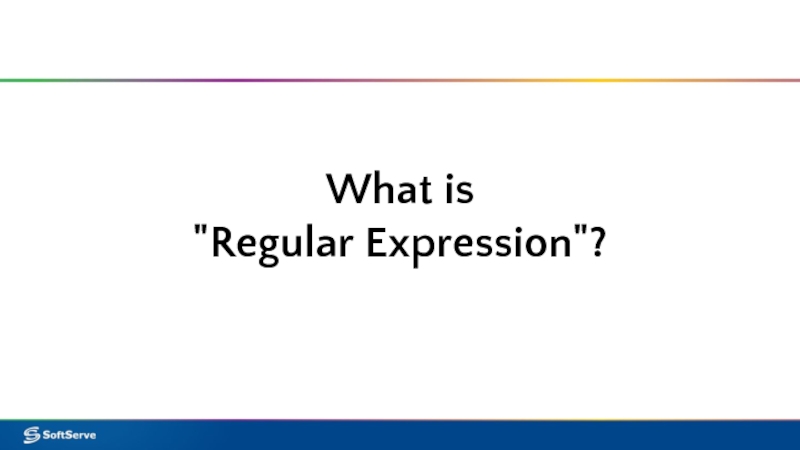
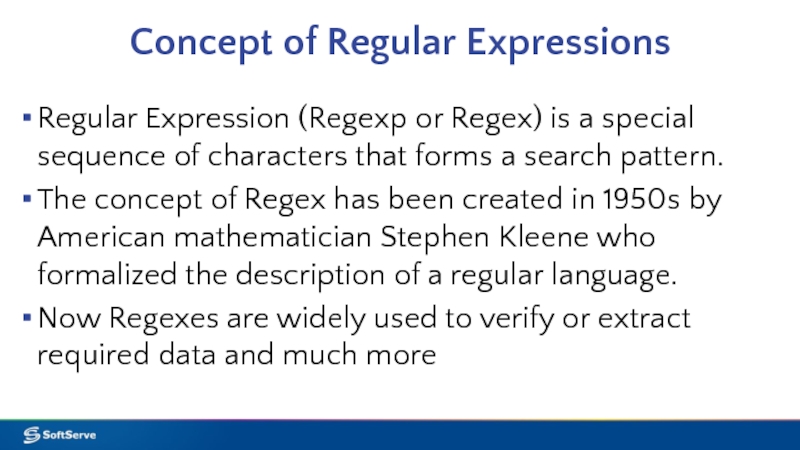
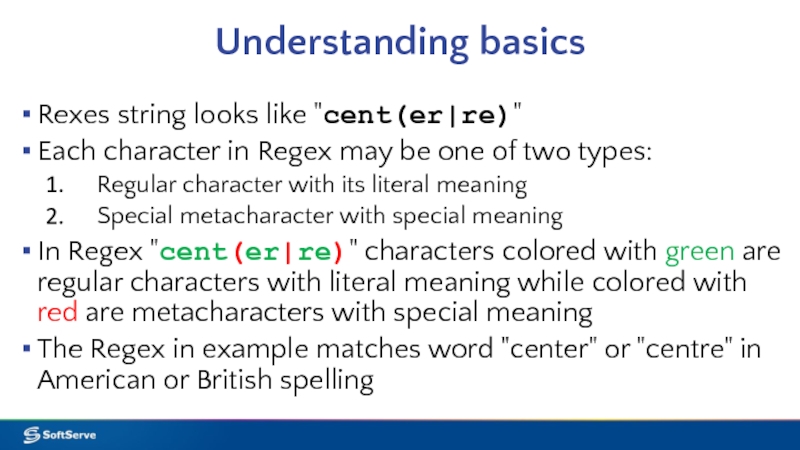
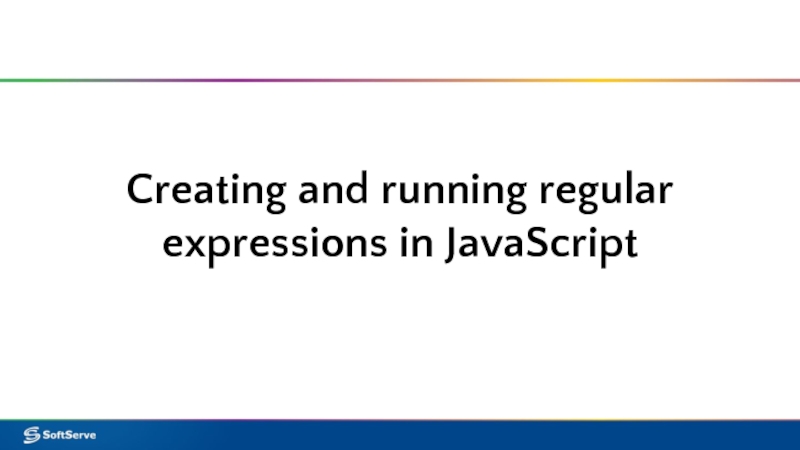
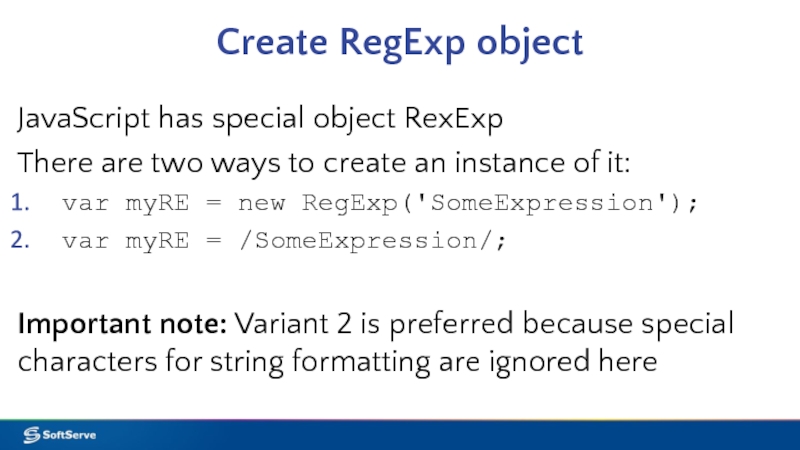
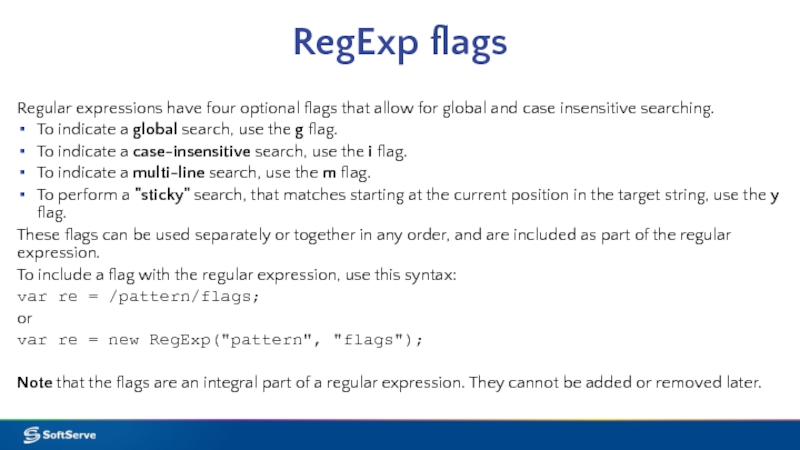
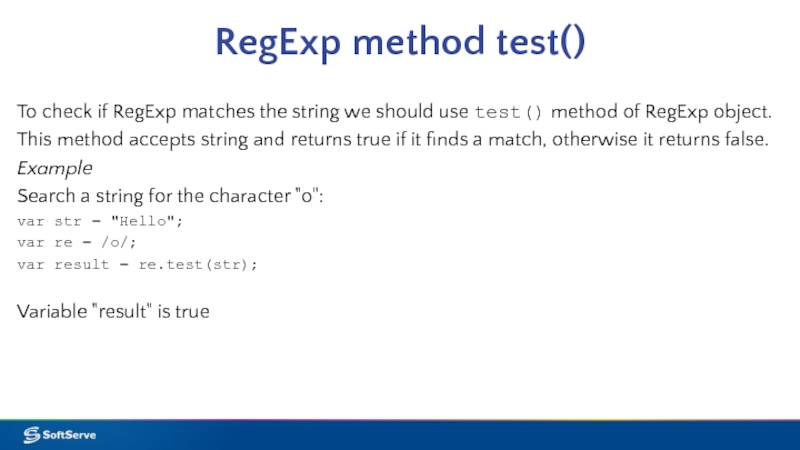
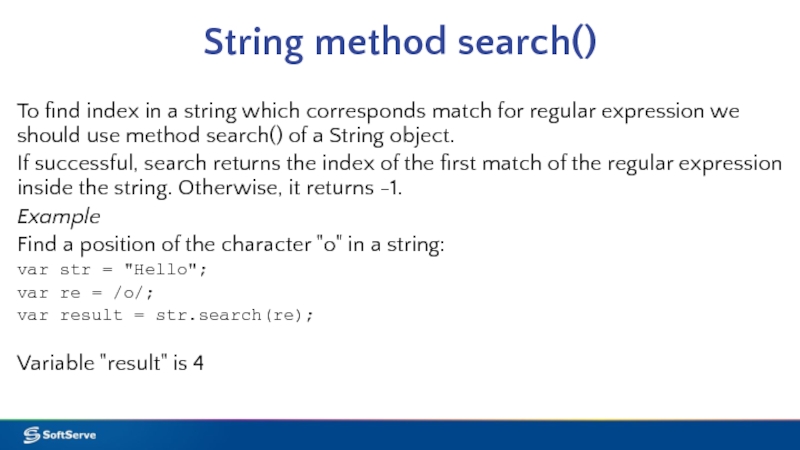
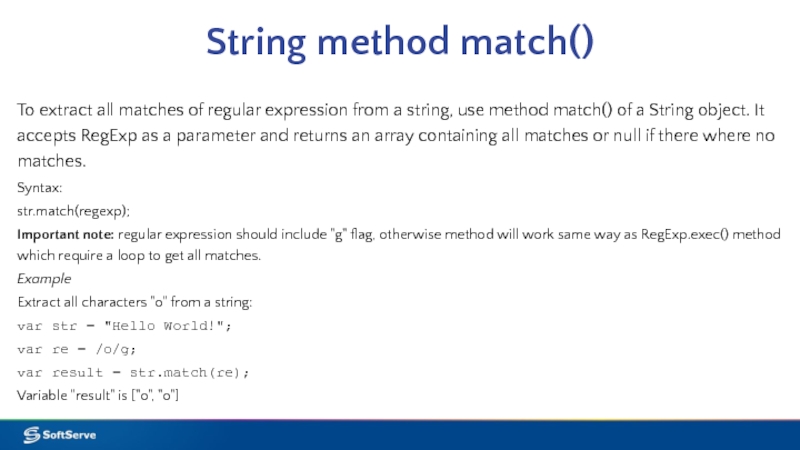
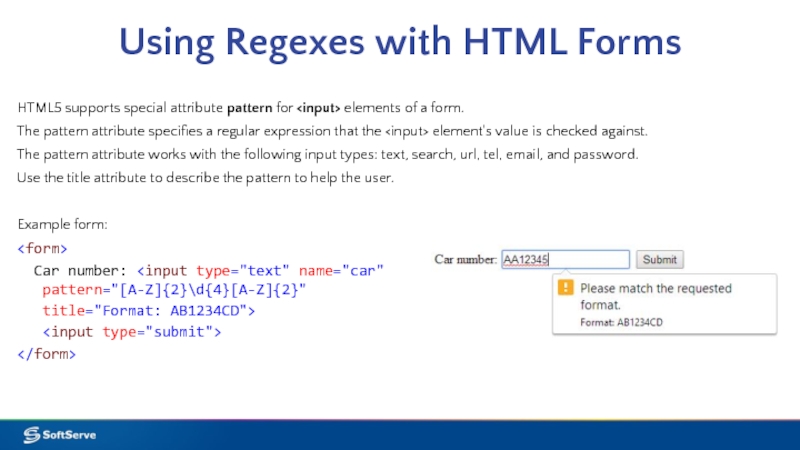
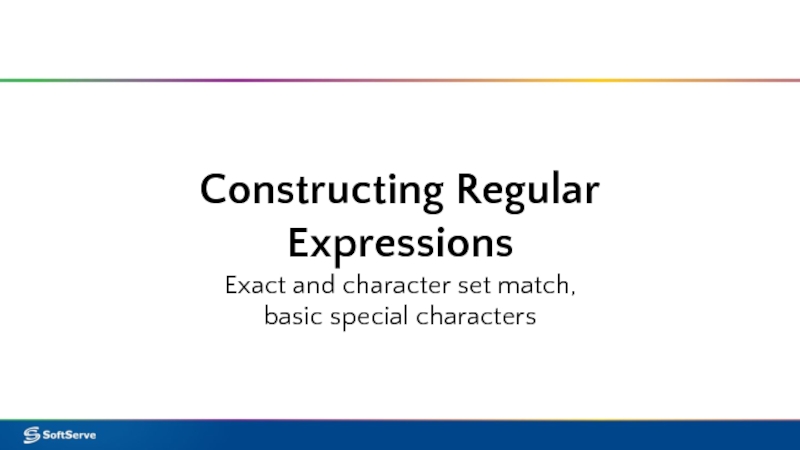
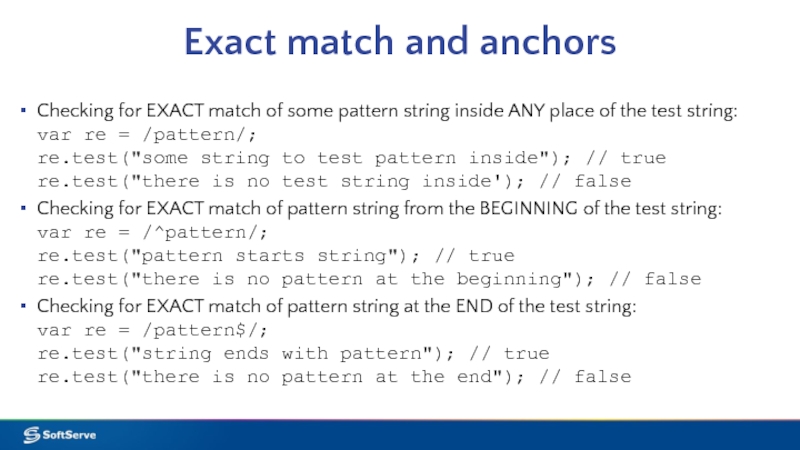
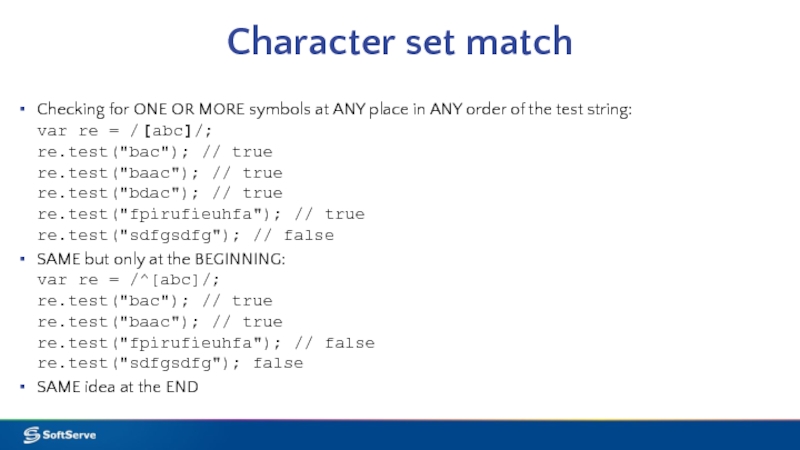
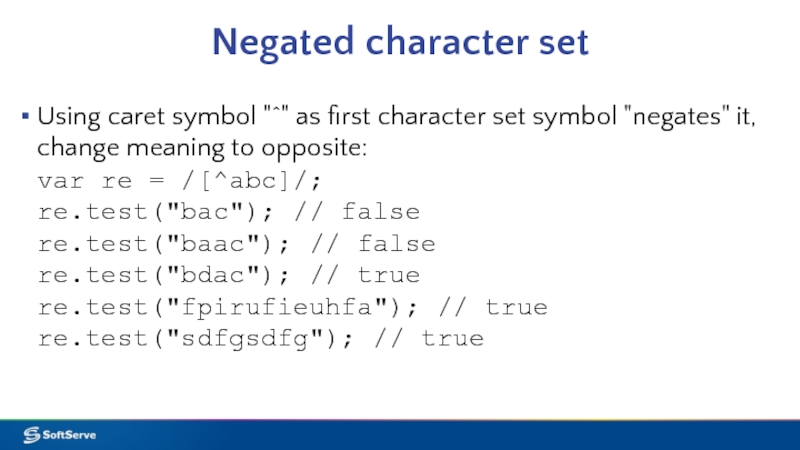
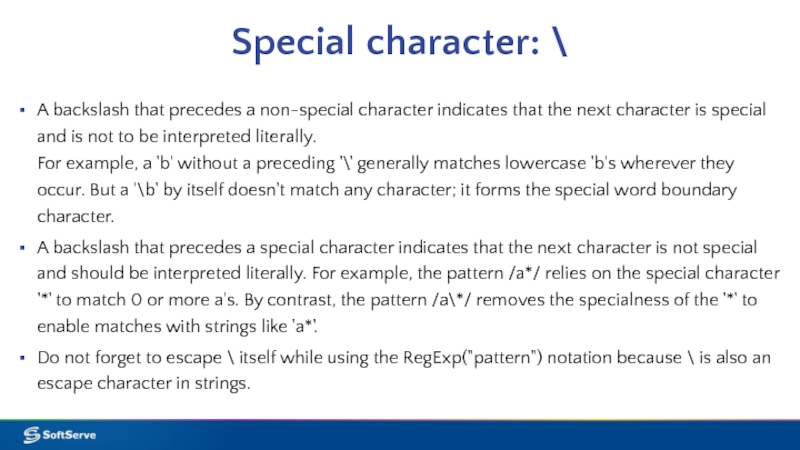
![Symbol rangesHow to specify symbol ranges? var re = /[a-z]/; // from a to z](/img/tmb/4/324999/7bfcea1448213f62f0313cc31c8e052f-800x.jpg)
